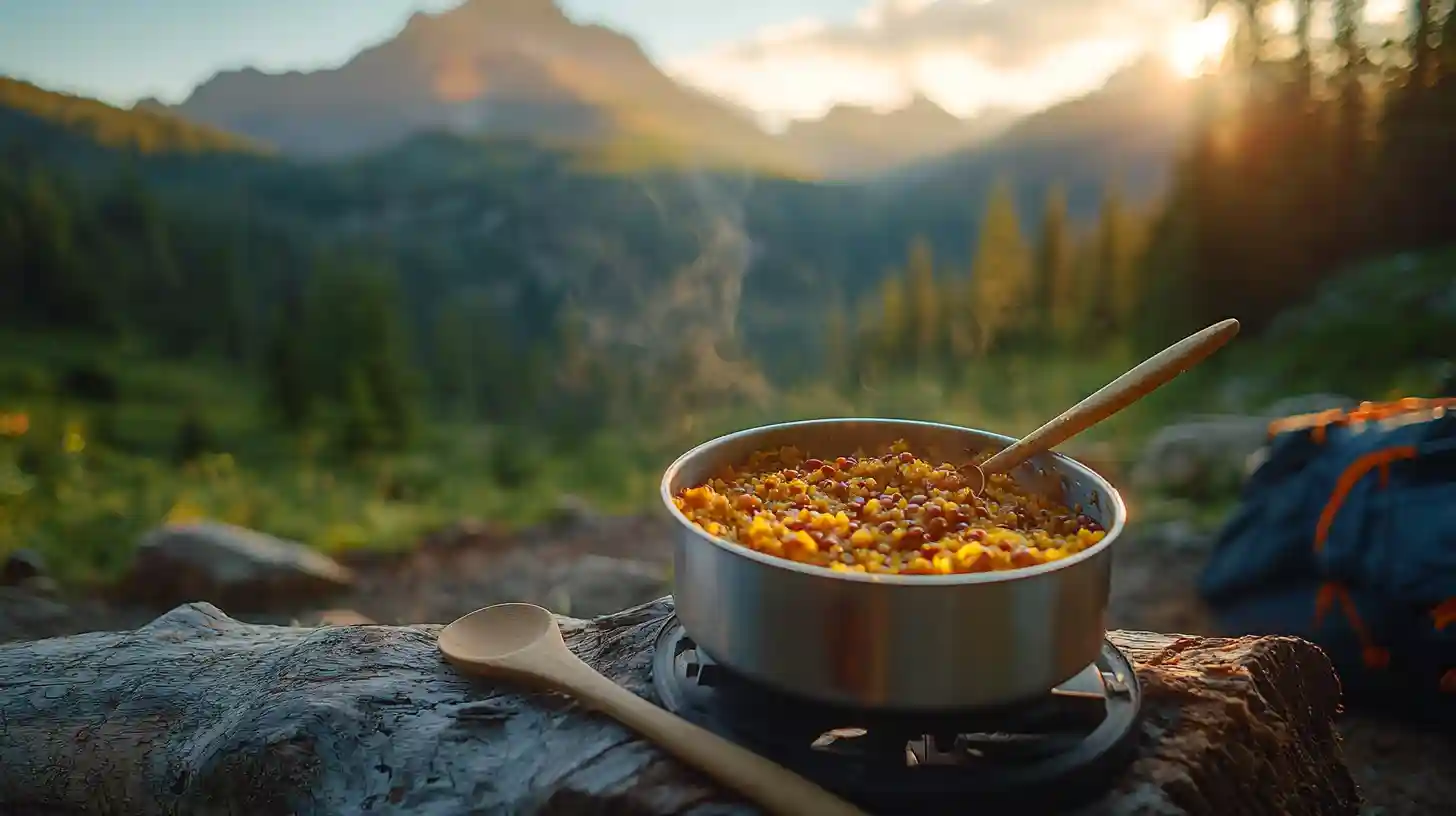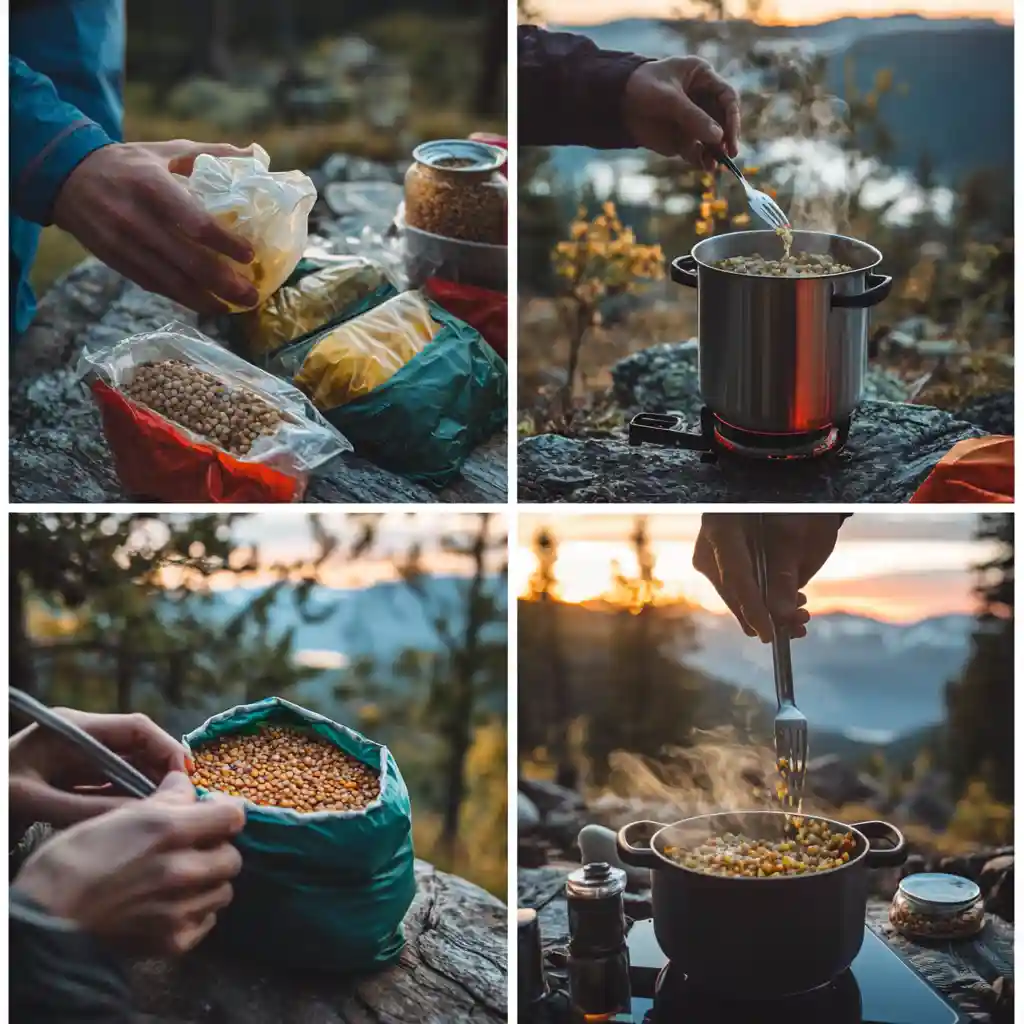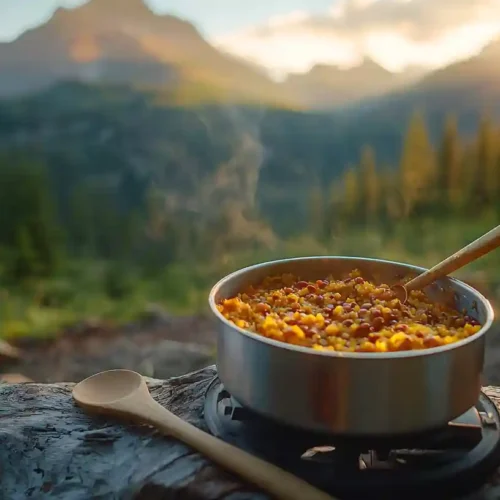
Table of Contents
Introduction
When it comes to embarking on a backpacking adventure, having the right meals can make all the difference. Preparing easy-to-cook and lightweight food not only saves space in your pack but also ensures you stay energized during your journey. Whether you’re traversing rugged trails or setting up camp by a serene lake, thoughtfully planned backpacking recipes offer a perfect blend of nutrition, convenience, and flavor.
Planning your meals ahead of time ensures you carry just what you need, making the trip lighter and hassle-free. Tools like this guide to food dehydration provide invaluable insights into how to prepare durable, delicious meals tailored for the outdoors. From dehydrating veggies to creating calorie-packed snacks, the possibilities are endless and rewarding.
Backpacking is more enjoyable when you pair great views with equally great meals. But it’s not just about convenience; it’s also about making sustainable choices. By exploring eco-friendly backpacking recipes and reducing food waste, you contribute to leaving a minimal impact on the beautiful landscapes you visit.
Why Backpacking Recipes Are Essential for Outdoor Adventures
For any outdoor enthusiast, proper meal planning is just as essential as the right gear. While it might be tempting to rely on store-bought meals, preparing your own backpacking recipes gives you the advantage of controlling the ingredients, flavors, and nutritional value. Additionally, creating your own meals often means avoiding preservatives and excess packaging, which are common in commercial options. As a result, you’ll have healthier meals and less waste to manage during your trip.
Moreover, the energy demands of hiking or camping make it crucial to pack meals that are both lightweight and calorie-dense. A well-thought-out plan ensures you stay fueled and ready for any challenge on the trail. For instance, recipes rich in complex carbohydrates, healthy fats, and proteins provide long-lasting energy. In contrast, sugary snacks might offer a quick boost but leave you feeling drained shortly after.
Furthermore, making your own meals gives you the flexibility to adapt to dietary restrictions, ensuring everyone in your group has suitable food options. For those who are new to backpacking, this nutrition essentials guide is a great place to start. It provides practical advice on balancing weight, variety, and calorie intake to create a seamless outdoor experience.
Tools and Ingredients for Easy Backpacking Recipes
When preparing backpacking recipes, having the right tools and ingredients can simplify the process significantly. First, a food dehydrator is invaluable for creating lightweight and long-lasting meals. Unlike fresh food, dehydrated meals take up less space and remain shelf-stable for weeks or even months. Tools like vacuum sealers are also essential for keeping your meals fresh and protected from moisture, which can spoil food during a trip.
Next, focus on stocking up on ingredients that are nutrient-dense and easy to prepare. For example:
- Grains: Rice, quinoa, and couscous are excellent bases for many dishes.
- Proteins: Lentils, beans, and nuts provide vital energy and sustenance.
- Fruits and Vegetables: Dried produce such as bananas, kale, and peppers add flavor and vitamins without the weight of fresh options.
- Seasonings: Don’t forget spices like paprika, cumin, and garlic powder, which elevate even the simplest recipes.

Above all, select ingredients that align with your taste preferences and dietary needs. As you plan, remember to pack items in reusable, lightweight containers to minimize waste and maximize portability.
Dehydrated Meals: A Backpacker’s Best Friend
Dehydrated meals are among the most practical options for backpackers, primarily because they’re easy to make, pack, and rehydrate on the trail. Whether you’re a fan of hearty stews or flavorful soups, almost any dish can be transformed into a lightweight meal with the right preparation. Importantly, dehydrated meals not only reduce pack weight but also eliminate the risk of spoilage.
To prepare a dehydrated meal:
- Cook the recipe as you normally would at home.
- Spread the food evenly onto dehydrator trays to ensure consistent drying.
- Set the dehydrator to the appropriate temperature (typically around 135°F for vegetables or 145°F for proteins).
- Once dried, pack the food into airtight bags or vacuum-sealed pouches.
For a delicious example, try dehydrating a black bean and sweet potato chili. Pair it with instant rice, and you’ll have a meal that’s both comforting and nutritious. To elevate your meals further, consider adding garnishes like Parmesan cheese or dried herbs, which pack tons of flavor without adding weight.
Healthy Backpacking Recipes for Sustained Energy
Not every meal on the trail requires cooking. Some days, you may prefer to eat something that doesn’t require boiling water or waiting. For those moments, no-cook backpacking recipes come in handy. These meals often require just a little preparation beforehand but provide a quick, energy-packed option during your trip.
For instance:
- Trail Mix: Combine dried fruits, nuts, and dark chocolate chips for an instant energy boost.
- Energy Balls: A mix of oats, peanut butter, and honey rolled into bite-sized portions.
- Wraps: Whole-grain tortillas filled with pre-made hummus, dried veggies, and a sprinkle of seasoning.
These options are ideal for lunch breaks or when you’re eager to cover more ground without stopping to cook. They’re also great for maximizing your time outdoors while keeping hunger at bay.
FAQs About Backpacking Recipes
What are the best ingredients for backpacking meals?
Ingredients like rice, lentils, dried fruits, and nuts are staples. They’re lightweight, nutrient-rich, and easy to prepare on the trail.
How long do dehydrated meals last?
When stored in airtight containers, dehydrated meals can last up to six months, though it’s best to consume them within three months for optimal flavor.
How do you rehydrate food on the trail?
Simply add boiling water to the dehydrated food, cover, and let it sit for 5–10 minutes. Stir occasionally to ensure even hydration.
Hot Meals: Comfort Foods for Backpacking
Sometimes, after a long day of trekking, nothing is more satisfying than a warm, hearty meal. Backpacking recipes for hot meals are not only comforting but also help replenish your energy levels effectively. These dishes are typically one-pot wonders, making them easy to prepare and clean up even in the wilderness.
For example, a mushroom and lentil bolognese paired with dehydrated pasta creates a delicious, protein-packed dinner that’s ready in minutes. Similarly, a simple ramen dish can be transformed into a gourmet experience by adding dehydrated vegetables, tofu, and a dash of chili oil. Not only do these meals warm you up, but they also ensure you’re getting the necessary nutrients after a physically demanding day.
Furthermore, the convenience of these recipes means you can spend more time enjoying your surroundings rather than focusing on cooking. By using a portable camp stove, meals like rice and beans with spices or a classic chili mac become quick and satisfying options for any backpacker.
How to Plan and Pack Your Meals
When preparing backpacking recipes, proper planning and packing are essential. Start by calculating how many meals you’ll need based on the length of your trip and your daily caloric requirements. For those seeking clarity on portion control and nutritional balance, a look at nutritional value explained in detail can offer valuable guidance.
When packing, opt for reusable, lightweight bags or vacuum-sealed pouches. These not only protect your food but also minimize waste. Additionally, organize your meals by day, so you’re not fumbling through your pack looking for the right items. Clearly labeled portions can save valuable time and reduce the risk of over-packing.
Moreover, keeping your meals balanced is vital. Include a mix of carbohydrates for energy, proteins for recovery, and fats for long-lasting fuel. By planning thoughtfully, you’ll ensure you have both variety and nutrition throughout your journey.
Elevating Your Backpacking Cuisine
While simplicity is key on the trail, there are ways to make your meals feel more indulgent. Adding small garnishes or extras can elevate your backpacking recipes without significantly increasing the weight of your pack. For instance:
- A small bag of Parmesan cheese or nutritional yeast can add richness to soups or pasta dishes.
- Lemon or lime juice brightens up stews and rice dishes.
- Packets of hot sauce or olive oil can bring depth to otherwise simple meals.
If you enjoy variety, even when outdoors, explore gourmet custard-inspired recipes that demonstrate how basic ingredients can create elevated dining experiences. These small touches ensure that your meals are both satisfying and memorable.
Sustainability in Backpacking Recipes
In addition to creating nutritious and delicious meals, it is equally important to think about sustainability when preparing backpacking recipes. By reducing waste and choosing eco-friendly options, you can help preserve the beauty of the landscapes you explore. For instance, packing your meals in reusable bags or containers not only minimizes waste but also protects your food from moisture. This small change can significantly reduce your environmental footprint.
Furthermore, consider using biodegradable utensils and dishes during your trips. Not only are these lightweight and easy to pack, but they also align with the principles of Leave No Trace. By taking steps to ensure you leave no lasting impact, you contribute to preserving the natural environment for future adventurers.
Another practical tip is to avoid single-use packaging as much as possible. Bulk-buying ingredients and preparing your meals in advance allows you to cut down on unnecessary plastic and reduce overall waste. Additionally, leftover food scraps can be composted if you’re camping in an area that permits it, making your trip even more environmentally friendly.
Quick and No-Cook Backpacking Meal Idea
While full meals are crucial, snacks play an equally important role in keeping your energy levels up throughout the day. Easy-to-carry options like trail mix or energy bars are perfect for quick refueling. These snacks can be customized to suit your preferences, ensuring you enjoy them as much as your main meals.
For example, a classic trail mix of nuts, seeds, dried fruit, and a touch of chocolate offers a balance of carbs, fats, and sugars that provide sustained energy. Alternatively, homemade energy bars with oats, honey, and peanut butter are a satisfying and budget-friendly alternative to store-bought options. These snacks are not only easy to prepare but also lightweight and non-perishable, making them ideal for backpacking trips.
Moreover, hydration is equally important when snacking. Pair your snacks with ample water or consider carrying electrolyte packets to replenish the salts lost through sweat. Staying hydrated not only supports your physical endurance but also ensures your meals and snacks are fully digested, providing maximum energy.
Experimenting with Flavors and Ingredients
One of the joys of preparing backpacking recipes is the opportunity to get creative with flavors and ingredients. While functionality often takes priority, adding a touch of variety can make your meals more enjoyable. For instance, using different spice blends can turn simple dishes like rice and beans into flavorful meals inspired by cuisines from around the world.
Consider creating spice packets tailored to your favorite dishes before your trip. A mix of cumin, paprika, and chili powder can transform a basic stew into a Tex-Mex delight. Similarly, adding dried basil, oregano, and garlic powder can give an Italian twist to your meals. These small packets take up minimal space in your bag but add maximum flavor to your dishes.
Additionally, experimenting with new ingredients can make your meals stand out. Dried mushrooms, sun-dried tomatoes, or powdered coconut milk can elevate simple recipes into something extraordinary. By thinking creatively, you can turn routine meals into memorable highlights of your trip.
Overcoming Common Challenges with Backpacking Meals
Despite the many benefits of preparing your own backpacking recipes, it’s important to address some common challenges. For instance, one issue many backpackers face is ensuring meals are adequately portioned for their calorie needs. Overpacking can lead to unnecessary weight, while underpacking leaves you hungry and fatigued.
To avoid this, calculate your daily calorie requirements based on your activity level. Most backpackers require between 2,500 and 4,000 calories per day, depending on the intensity of their hike. Use tools like calorie calculators to determine portions that meet your needs without excess.
Another challenge is keeping your meals fresh and safe from spoilage. Always store food in airtight containers, and if possible, include moisture-absorbing packets to extend the shelf life of dehydrated meals. Lastly, always pack an extra meal or two for emergencies. While you may never need them, having backups provides peace of mind and ensures you’re prepared for any situation.
Conclusion: Preparing for Success
To sum up, mastering backpacking recipes is an invaluable skill for anyone who loves the outdoors. By preparing your own meals, you’ll enjoy better nutrition, lighter packs, and tastier food than most pre-packaged options can offer. Whether you’re making dehydrated meals, quick no-cook options, or comforting hot dishes, the right planning ensures you’ll have the energy and satisfaction needed for every adventure.
Moreover, by incorporating eco-friendly practices like reusable packaging and reducing food waste, you contribute to preserving the natural beauty of the trails. So, as you prepare for your next trip, don’t underestimate the power of great meals to enhance the experience.

Backpacking Recipes
Ingredients
- Grains: Rice quinoa, couscous
- Proteins: Lentils beans, nuts, tofu
- Fruits and Vegetables: Dried bananas kale, bell peppers
- Seasonings: Paprika cumin, garlic powder, chili powder
- Other: Instant pasta powdered coconut milk, olive oil, nutritional yeast, hot sauce packets
Instructions
- For dehydrated meals:
- Cook your meal at home.
- Spread it evenly on dehydrator trays.
- Dehydrate at 135–145°F.
- Store in vacuum-sealed bags for up to 6 months.
- Rehydrate on the trail by adding boiling water and letting it sit for 5–10 minutes.
- For quick, no-cook meals:
- Prepare ingredients in advance (e.g., mix trail mix, prepare wraps, or roll energy balls).
- Pack in lightweight, reusable containers.
- Consume directly on the trail for instant energy.
- For hot meals:
- Boil water using a camping stove.
- Add dehydrated meal components and let them rehydrate.
- Stir occasionally and season as desired.
- Enjoy with optional garnishes like cheese, herbs, or sauces.
Notes
- Storage Tip: Store dehydrated meals in vacuum-sealed pouches for extended shelf life.
- Sustainability: Use reusable containers and avoid single-use plastics.
- Customization: Pre-pack spice blends to enhance flavors without extra weight.
- Emergency Preparedness: Always carry an extra meal in case of delays or emergencies.
| Tested by MacMar – founder of Flavivo Recipes and a U.S.–based backpacker. Every meal in this guide was cooked on an ultralight fuel-tablet stove during a weekend trek through the Rockies to prove the recipes work in real-world trail conditions. |
